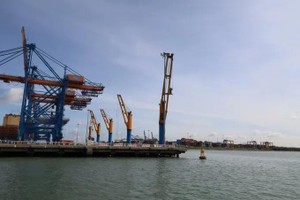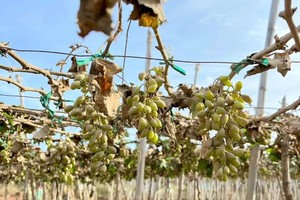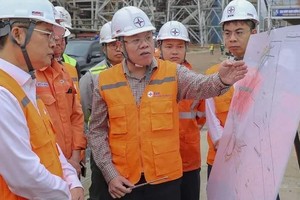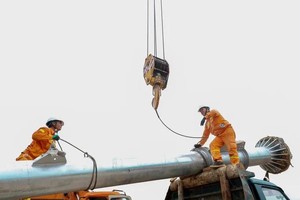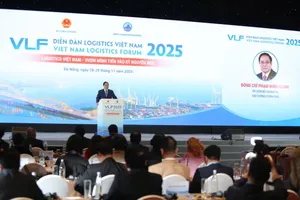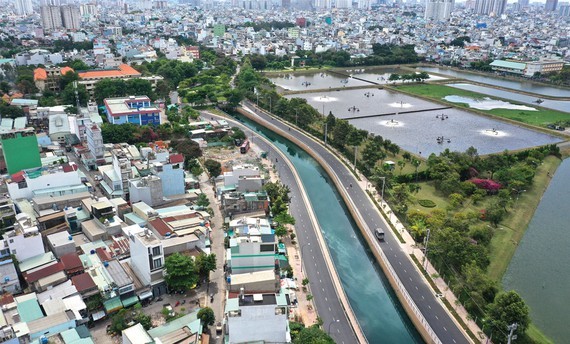
Works to complete in April
The Thủ Thiêm 2 bridge project is expected to be completed and in use before 30 April. This project was started in 2015, covering a length of 1.4 kms with six traffic lanes, and connecting the two banks of the Sai Gon River from Thu Thiem New Urban Area and Thu Duc City to the center of District 1. The Thủ Thiêm 2 Bridge has an investment of nearly VND3,100 bn, with the first intersection along Ton Duc Thang and Le Duan streets in District 1. From there it will connect the Sai Gon River to the arc boulevard on Route R1 in Thu Thiem New Urban Area.
This project is being implemented under the model plan of Build-Transfer (BT), with investments by the Dai Quang Minh Real Estate Joint Stock Company. Initially, the City expected the bridge to be complete in 2018 but it encountered many problems, and hence there was a delay. When complete, the project will help reduce traffic load at the intersection of many arterial roads in District 1, namely, Ton Duc Thang, Nguyen Huu Canh, and Le Thanh Ton streets. It will also promote socio-economic development of Thu Duc City in particular and Ho Chi Minh City in general.
The project to expand the Dong Van Cong road and My Thuy 3 bridge will also be completed within April, and will help in reducing traffic jams and unfortunate accidents on this route. It will also increase the carrying capacity for the gateway of Cat Lai Port. The My Thuy 3 bridge, part of the My Thuy intersection project, has a total investment of nearly VND57 bn, and covers a length of 325 meters. The bridge is 75 meters in length and divided into two sections with each section being 12 meters in width.
This year, Ho Chi Minh City will focus on developing transport infrastructure projects to help increase regional connectivity and reduce congestion. In particular, the parallel road construction project on Vo Van Kiet in District 1 is completing its last stages so as to be ready to open for traffic within April. This project has a total investment of VND54 bn, starting 5 May 2021. The route covers a length of 615 meters with a width of 7 meters, located along Vo Van Kiet Boulevard, along the banks of the Tau Hu canal, and under the Calmette bridge. This is also an arterial road, linking Ho Chi Minh City with neighboring provinces.
The project of upgrading and renovating Nuoc Den roads and canals was started in the first quarter of 2020 with a total investment of VND 629 bn and is also expected to be completed before 30 April. This project has been completed after two years, and will help people to commute more easily and also improve the environment in this area. Currently, both sides of the bank have embankments to make it more secure, and at the same time, a railing higher than 1.5 meters has been installed. The project has changed the outlook of Ho Chi Minh City in general and Bình Tân district in particular.
Lê Lợi street in District 1 is expected to reopen on the historic occasion of 30 April. Since mid-2014, most of Le Loi street and the section from Đồng Khởi street to Pasteur street, has been fenced off by contractors to complete the construction of the Ho Chi Minh City Opera House underground station. Currently, the contractor of Metro Line 1 is making efforts to fill the land and speed up the progress to promptly return the ground back to the Department of Planning and Architecture. Lê Lợi street will become a future highlight and a busy commercial street that will attract many tourists and residents.
Great projects underway
During the month of April, the Government has proposed to the National Assembly to approve a number of specific mechanisms for the Ring Road 3 project in Ho Chi Minh City to meet the completion schedule by 2026. On the basis of a pre-feasibility study report for the project under Ring Road 3 of the Ministry of Planning and Investment, the National Assembly will consider and approve the project investment policy at the next meeting in May.
Ring Road 3 covers 76.34 kms with the starting point in Nhon Trach district in Dong Nai province, and the endpoint in Ben Luc district in Long An province. The section through Ho Chi Minh City is 47.51 kms in length, in Dong Nai it covers 11.26 kms, in Binh Duong it covers 10.76 kms, and in Long An it covers 6.81 kms. The total investment in phase 1 of Ring Road 3 will be VND75,378 bn, in which land acquisition and resettlement costs account for VND43,589 bn, and construction and equipment costs are around VND25,945 bn.
The expected progress from 2022 until project preparation will be site clearance for resettlement until 2024, with the project starting at the end of 2023 and completing in 2026, with a final settlement in 2027. According to the Government, the investment in Ring Road 3 in Ho Chi Minh City is very necessary and urgent. Specifically, the project has the role of linking regions, promoting urbanization, creating momentum and spillover, and promoting socio-economic development of the localities, as well as the whole country. In particular, the project will also contribute to reducing pressure on the inner city of Ho Chi Minh City and will limit traffic congestion in the area to a great extent.
The Ring Road 3 project is located in Ho Chi Minh City and Tay Ninh province, starting from Ring Road 3 in Cu Chi district which is the route parallel to the existing National Highway 22. The last section connects to National Highway 22, and the Moc Bai border gate area. The route will have eight lanes, and the remaining section in Tay Ninh province will have six lanes. The length of the entire expressway is 50 kms, of which the section through Ho Chi Minh City is 23.7 kms in length. In phase-1, the project cost will amount to around VND15,900 bn.
According to the People's Committee of Ho Chi Minh City, the above project aims to meet travel and freight needs and reduce the load on National Highway 22. This will be a Trans-Asia traffic route, connecting economic centers, border-gate economic zones, and urban centers of the Southern key economic region with seaports, international airports, and the ASEAN economic region.
